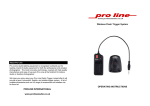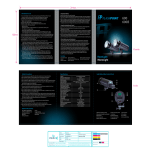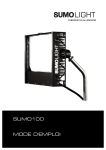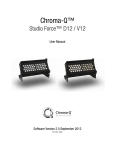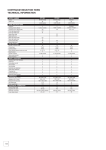Download Pro Line Studio Apollo X-180
Transcript
About Pro Line Pro Line’s studio lighting equipment is recognised worldwide as the leading brand of studio equipment for both the professional and amateur photographer. The most innovative technology, coupled with high quality manufacture and ease of use puts Pro Line at the forefront for today’s studio or location photographer. OPERATING INSTRUCTIONS PROLINE INTERNATIONAL www.prolinestudio.co.uk Lighting Setups Below is a diagram of the basic 1, 2, 3 and 4 lighting setups. Each light is used for a specific purpose and are known as the Primary, Fill, Background, and Rim/Flair light. Primary – This is the main light in a setup, and in cases where it is used with other lights will normally be the brightest. 1. Modelling Light Switch 2. Power Indicator 3. Flash Power Control 4. Photo Cell Switch 5. Mains Power Switch 6. Sync Cable Socket 7. Power Socket 8. Flash Test Button 1. 360 Deg Photo Cell 2. Umbrella Holder 3. Lamp Tilting Bracket Fill – This is the second light in a setup, where a second light is not available a reflector can be used to bounce light from the Primary light back to the subject from an opposing angle. The Fill light is used to remove shadows created by the Primary light. Background – A third light can be used to illuminate the background behind your subject. Rim/ Flair – This is used to add another dimension of illumination to your subject it can help separate the subject from the background and accentuate details such as hair. 1 Light Setup 2 Light Setup 3 Light Setup 4 Light Setup Safety Notes Accessories Barn Doors Barn doors are designed to control the direction and spread of the light. They can also be used with coloured gels. The Apollo lights must not be used in an environment where moisture or flammable vapour is likely to come into contact with the unit. Avoid touching either the modelling or flash bulbs with bare hands. This will shorten the life of the bulb and cause it to blacken. Do not operate if the cord or unit has been damaged. Snoot A snoot focuses the light precisely and can be used to highlight an area. Operation Please check the contents to ensure all the items are present and correct. Fit the modelling bulb to the unit, and use the mains lead supplied to connect to the mains supply. Switch the unit on via the power switch on the back panel. Umbrella Umbrellas can be used to reflect or diffuse light and to create cooling or warming lighting effects. Reflector The reflector attaches to the front of the light and helps to focus the light in a specific direction. Reflector It is recommended that you charge the unit for 1 hour prior to initial use and/or after a long period of inactivity. Set the power control to desired level. The charge indicator will illuminate and the there will be an audible beep when the unit is fully charged and ready to use. Both the modelling bulb and the photo cell can be turned of independently using the switches at the rear of the unit. The flash unit can be triggered in three ways: Manually using the test button. Via the sync socket Using the built in photocell enabling the unit to be triggered by any other flash, the built in flash on a camera, a camera mounted flash gun or by infra-red. We hope you enjoy using this lamp. Used to reflect the light towards the subject and, depending on what side is used, can produce a cooling or warming effect. SPECIFICATIONS Equipment Bag The padded equipment bags help to protect the equipment either in the studio or on the move. Background Support System Can be used to hang paper, cloth and vinyl backgrounds. X-180 Apollo X-300 Apollo Output 180 w/s 300 w/s Guide Number 35GN 48GN Recharge Time 3.0 sec 3.6 sec Colour Temp 5500 K 5500 K Power Control Full to 1/8 fully variable Full to 1/8 fully variable Modelling Lamp 50W 50W Flash Duration 1/1000 sec 1/1000 sec Triggering Methods Slave / Infrared / Sync Cable Slave / Infrared / Sync Cable Sync Voltage 6V DC 6V DC Light Stand Replacing the Flash Tube Set up the light stand to the required height and remove the white plastic cap from the top. The legs should be positioned as far apart as possible in order to obtain the most stability. Umbrella Turn off the unit and disconnect from the mains supply and press the Flash Test Button in order to discharge any stored power. It is recommended that you wait 30 minutes before touching either the flash or modelling bulb. Unwind the twisted trigger wire from the flash tube and gently pull the flash tube assembly out of the unit. Remove the umbrella from the protective sleeve. Pick up the replacement flash tube with either a clean cloth or paper towel, taking care not to touch it with your bare hands, and gently but firmly insert it into the unit. Wind the trigger wire back around the flash tube ensuring that it is not touching the metal reflector, (if the wire is in contact with any other part of the unit it will fail to operate). Open the umbrella fully so that it locks into place. Always replace with the correct flash tube. Insert into the Umbrella Holder located directly under the light. Softbox Please check the contents to ensure all the items are present and correct (Fig 1): Replacing the Fuse The fuse is located directly above the Power Socket on the rear of the light. In order to replace the fuse, unplug the power lead from both the mains and the light, the fuse tray can then be pulled out and the fuse replaced. The F-180 Apollo & F-300 Apollo lights require a 10 amp fuse. 1 x Black / Silver Outer Cover 1 x Speedring 4 x Rods 1 x Internal Diffuser 1 x Translucent Outer Diffuser Cover Triggering Methods Camera Flash The Pro Line flash lights have built in Slave Sensors and so can be triggered by the use of flash gun or by the cameras built in flash. Fig 1 Fig 2 Fig 3 Fig 4 Fig 5 1. Place the black outer cover on a flat surface with the silver lining facing upwards. 2. Place the speedring in the centre of the outer cover with the widest part facing upwards (Fig 2). 3. Insert the rods into the speedring and locate the other end of one of the rods into one of the small pockets located around the edge of the outer cover. Repeat this with all the other rods, starting with the opposite rod to the one just fitted until all rods are in place (Fig 3). The rods will bend sufficiently for this to happen. 4. Attach the inner diffuser onto the outer cover (Fig 4). 5. Attach the outer diffuser to the front of the softbox (Fig 5). 6. The softbox can now be fitted to the light. Sync Lead One end of the sync lead plugs into the camera and the other end plugs into the sync socket of the flash light. Infrared Trigger The infrared trigger fits directly onto the hotshoe of the camera. The test button should be pressed in order to start the charge cycle. Radio Trigger The radio trigger has two parts; a transmitter, that fits onto the hotshoe of the camera and a receiver that plugs into the sync socket of the flash light.




